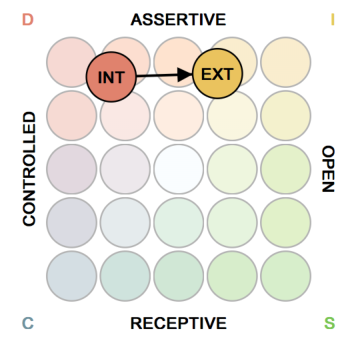Your regular update of news and articles from the world of DISC personality profiling with the Discus solution.

Published: Tuesday 17 October 2023

An example of a Discus Style Card
A 'Style Card' is a quick and convenient way of summarising a personality style on a simple two-dimensional grid, and you'll find a whole set of these Style Cards inside a Discus report.
The most important of these is the 'Primary Style Card' that sums up a person's entire personality, but this is followed by a selection of specialised Cards looking at the ways a person can be expected to behave in different settings.
Starting from a DISC profile, we can work out where a person lies on two critical axes. The first of these relates to how willing a person is to take direct, pro-active action (Assertive) or to instead react to events around them (Receptive). The second axis describes how a person interacts with others, from sociable and uninhibited in approach (Open) to cautious and formal (Controlled).
By calculating where a personality lies on each of these axes, we can plot that personality on a Style Card grid, as shown in the example, and see immediately how it compares to the population as a whole.
These basic ideas are in fact core concepts that underlie DISC itself, and you can see how they relate on the example Style Card shown here. Each of the four DISC factors represents a confluence of these factors, so - for example - someone who is Assertive and Controlled has a Dominant personality. You'll see the four DISC factors marked at the corners of a Style Card to show how these combinations work.
All these ideas come together in Discus' 'Primary Style Card', which creates a straightforward overall personality summary. Unlike the other Style Cards (which we'll look at shortly), the Primary Style Card plots two different personality variants, based on the Internal and External profiles. In other words, it shows a person's more natural responses (marked 'INT' for 'Internal') and, connected by an arrow, the ways that person is adapting their style at present (marked 'EXT' for 'External').
Often these two markers are very close together, representing an individual who feels little need to modify their style. In cases like our example here, however, there can be some distance between them, and the arrow on the Style Card summarises the kinds of changes in action. In this particular case, the candidate evidently feels a need to show a much more open and sociable attitude to those around them than might more typically be the case.
Connected with the Primary Style Card is a checklist based on the location of the individual style on the grid. This is a handy way of summarising the core features of a personality before the report moves on to a more substantial analysis. Here you'll find, for example, a selection of keywords that describe a person's behavioural type, as well as quick assessments of their values, motivators and likely responses to pressure.
A useful feature of the Style Card idea is that we can adjust our view of the axes to create layouts relevant to the various different situations. Note that the axes themselves do not change; rather, we adjust the terms used to describe them to highlight important underlying factors. For instance, the Work Style Card recasts 'Controlled' and 'Open' as Procedure and People respectively, using terms more relevant to a working situation.
Where the Primary Style Card plots both Internal and External personality styles, the other Style Cards in the report keep things simpler by using only one of these in each case, with the particular selection depending on the Style Card in question. So, the Work and Leadership Style Cards uses the External profile, as that is directly relevant to a person's current working situation, but the Communication and Learning Style Cards use the more natural Internal profile.
Work Style CardThis Style Card describes a person's general attitude and approach in a working situation, including their most specific advantages and disadvantages. |
Leadership Style CardThis Style Card describes how a person will likely respond to different leadership or management strategies, and how they can be most effectively motivated. |
Communication Style CardThis Style Card describes a person's social style and approach to communication, also considering approaches that they are likely to find most persuasive. |
Learning Style CardThis Style Card describes the most important features of a person's learning style, and the training and coaching strategies that are likely to be most productive. |
There's a whole lot more information about Style Cards in theory and in practice in the Style Card section of the Discus Understanding DISC guide.